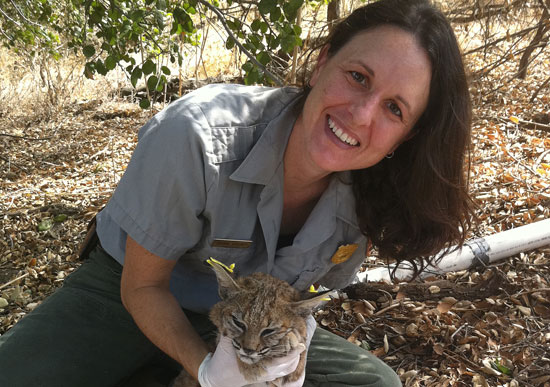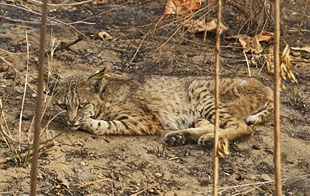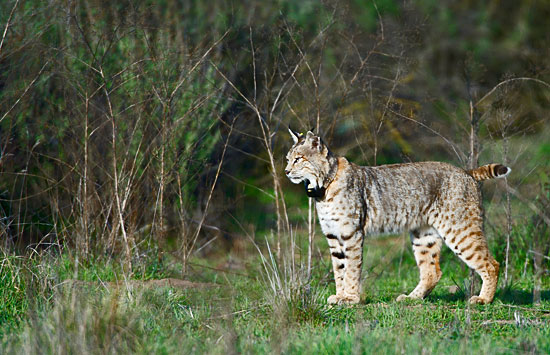When nine lives aren’t enough
June 20, 2013

Wildlife biologist Joanne Moriarty says fire adds yet another dimension to the stresses on the region's bobcats.
The sighting was unusual and upsetting. Just days after fire-ravaged Sycamore Canyon re-opened, worried hikers began to report seeing a bobcat sitting passively on a charred trail. Alarmingly skinny, she was not running away. Her whiskers were singed, and it was clear she’d had an earlier encounter with people. Her ears, they said, were tagged.
National Park Service officials, who’ve been tracking and studying bobcats in the Santa Monica Mountains for years, searched the canyon but couldn’t find the spotted cat. Then, earlier this month, a report came that left no uncertainty about the animal’s condition or location. A hiker found her dead a few miles beyond the Point Mugu State Park campgrounds, north of the Los Angeles County line.
Wildlife ecologist Joanne Moriarty of the park service says the bobcat’s entire “home range,” or habitat area, had been incinerated. “But the biggest thing was that her paws appeared to be burned. She couldn’t hunt or walk very well.”

This bobcat, its paws burned, would later be found dead by hikers as a result of the Springs fire in May.
The bobcat’s death, announced last Thursday on the Facebook page of the park service’s Santa Monica Mountains National Recreation Area, prompted an outpouring of comments lamenting the animal’s fate. One mountain biker, who’d seen the bobcat on the trail, said “it was the saddest thing to have to walk away from [her]. RIP beautiful cat.”
But the death also came with an irony for park service researchers—and a lesson for the broader public living in the region’s tinder-box conditions.
Several years ago, the bobcat—known simply as B274—had been captured, tagged and monitored with 16 others as part of control group for a landmark study of bobcats in the area’s more urbanized areas, such as Thousand Oaks and Westlake Village. There, the animals had been hit with an epidemic of potentially deadly mange. Researchers theorized that the cats’ immune systems had been compromised by eating rats poisoned with anti-coagulants, the most commonly used method of rodent control. Meanwhile, the control group, outfitted with GPS collars and living in the wilds, showed no evidence of mange or other immune problems.
But, in the end, bobcat B274—and probably many others—couldn’t be saved from another modern-day reality: An estimated 94 percent of wildfires in the Los Angeles region’s mountains are ignited not by nature but people acting carelessly, negligently or maliciously. “Even though these bobcats were in a much more natural area,” Moriarty says, “in reality they were still highly affected by human causes.”
According to investigators, the rampaging Springs fire, which came at an extraordinarily early time in the year, was accidentally caused by an “undetermined roadside ignition of grass and debris,” most likely from a passing vehicle.
Moriarty says that bobcats, which are solitary and territorial, are already stressed because their habitat has been sliced by roads and shrunken by developments. Now, with officials this week warning of fire conditions that look to be the worst in a century, she and other scientists worry that the toll on wildlife could be profound, especially with fires flaring earlier in the year because of worsening drought conditions.
Moriarty feels certain, for example, that bobcat kittens were killed in the Springs fire because it came during the “denning” season, when mothers are caring for litters of up to five kittens in the mountain underbrush. Of the 5-year-old bobcat found on the trail, Moriarty says, it’s “very possible she may have had kittens.”
And this, of course, raises broader concerns about survivability. “Anything that affects reproductive timing has huge impacts on a population’s ability to exist,” says biologist Laurel Serieys, who’s been collaborating with the National Park Service on bobcat research and runs a website called Urban Carnivores. “Human impacts on the environment and the wildlife extend far beyond the city boundaries.”
Exactly how many bobcats survived the wind-driven flames that hop-scotched through Sycamore Canyon is unknown. “Definitely, some of them are going to end up perishing,” Moriarty says. Budget permitting, she says, she’d like to set up remote cameras to track possible survivors and document the challenges they’ll surely face.
“As a person, it makes me sad,” Moriarty says of the likely bobcat deaths. “But as a scientist I find it interesting. We’ll have an opportunity to learn how even those who managed to escape are still going to be negatively impacted by the fire.”

National Park Service officials have undertaken the largest study ever of bobcats, monitoring them in the Santa Monica Mountains with GPS collars. Photo/Pete Padilla
Posted 6/20/2013












 405 bridge work causes a stink
405 bridge work causes a stink
